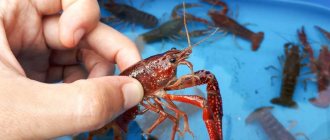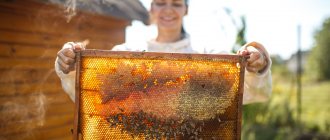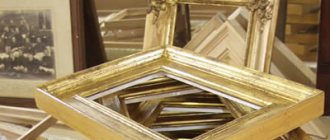Many people consider beekeeping an interesting and promising activity that does not require much labor or material investment. But in reality, before you start breeding bees, you should study their biology, become familiar with the rules of care and the sequence of seasonal work. In addition, significant investments will be required if you want to subsequently make a profit from this business.
To answer the question: “Is beekeeping profitable?” was positive, it is necessary to stock up on beekeeping equipment and provide insects with comfortable living conditions.
Preparation
First of all, you should prepare for unforeseen circumstances. Therefore, you need to buy not one bee colony, but at least 3-4. Over time, you can gradually increase your apiary.
Many beginners are interested in how many individuals there should be in a family. We answer - the number of insects can vary from 20 to 100 thousand, depending on the season and the strength of the swarm.
It is believed that it is best to start bee breeding with three colonies. But if you plan to turn your hobby into a business, you will need to purchase at least 50 bee colonies over time.
The location of the hives in the apiary.
It will also be interesting for a beginner to know that a bee colony collects about 20 kilograms of nectar per day, which will ultimately yield 10 kilograms of honey.
It wouldn’t hurt to join the beekeepers’ union. Its members help beginners and are always ready to provide useful tips on keeping bees. You can also purchase beekeeping guides for beginners.
Many beginners are afraid of bee stings. But these insects simply do not sting, since after the bite they die. To avoid bites, you should not make sudden movements or make loud sounds, and wear clean, light, lint-free clothing that does not contain foreign odors. A special smoker is also used to calm the patients. Over time, the bees recognize their owner and sting him extremely rarely.
So, a novice beekeeper needs:
- choose a place for an apiary that meets general requirements;
- purchase beekeeping equipment;
- select a breed so that it feels good in the local climate and is characterized by high productivity;
- Learn the basics of beekeeping for beginners.
Video: Organizing an apiary, beekeeping rules, equipment
You should make an acquaintance with an experienced beekeeper with solid experience. Not everyone is ready to share secrets. God is their judge. However, half are willing to help beginners - beekeepers in their first steps. It is important to understand that beekeeping in the Moscow and Sverdlovsk regions is very different. In many ways, the success of beekeeping technology and the development of an apiary depends on the correct first steps. For those who decide to take up bees, beekeeping forums on the Internet will be interesting and informative. Reading printed periodicals, such as the Beekeeping Magazine, which has been published since 1921, is beneficial.
A lot of necessary information can be obtained on YouTube video channels of existing beekeepers. In 2020, on YouTube they not only tell the theory, but also show live video recordings from apiaries. View lectures by famous beekeepers V.G. Kashkovsky. or Cebro V.P. won't be a big deal.
Purchasing bee colonies
Before breeding bees, you need to buy layerings or bee colonies. It's better to do this in the spring. The cost of a family at this time will be higher, but it will immediately produce honey and allow you to get layering.
Insects should be purchased at a distance of at least 5 kilometers from the apiary so that they do not return home. It is advisable to buy dry frames along with them. They are necessary for expanding families. It is better to make a purchase from familiar beekeepers or on recommendation.
You should go shopping after lunch, taking with you either your own hives or special boxes for frames. After purchase, all frames are rearranged into the hive (the frame with the queen is placed first) in the same order as they were originally.
Then they are secured with a board so that they do not move during transportation. They place their hive in the place of the owner's. Flying bees, returning with a bribe, will fly into a new house. Next, they simply close the taphole and take away the structure.
When purchasing a bee family, you should pay attention to several points:
- a sufficient number of flying individuals must sit on the frames containing the brood;
- there should be no gaps during sowing - such brood is called variegated;
- different colors of cells and perforation of the lids may indicate a disease;
- if there are a lot of crawling bees in front of the hive, many of which have deformed wings, then they are sick.
If you have even the slightest suspicion of a disease, then it is better to refuse the purchase.
What a novice beekeeper should know when choosing bees
It is recommended to buy bees at the beginning of the season, despite the fact that at the end they are sold much cheaper. When purchasing bee colonies along with their dwellings, they must be carefully inspected in order to correct any noticed deficiencies in a timely manner. Individuals differ in appearance and character. Their formation took years and depends on the habitat. The most common are:
- Krajina;
- Central Russian;
- Carpathian;
- gray mountain Caucasian.
However, you can only find a pure breed in a specialized nursery due to the widespread occurrence of nomadic apiaries. Although there is no point in striving for this, according to experienced beekeepers, all bees are good in their own way. In addition, there is no guarantee that the brought individuals will not begin to swarm in the new area, even if it is rich in honey plants. Among the common breeds, Central Russians tolerate long winters best, but are more aggressive than Caucasian breeds, which prefer warmer climatic conditions.
So, the best choice for a beekeeper will be the type of insect that is adapted to his climate. Such individuals can be purchased from local sellers, who can also give useful advice to a novice beekeeper. In addition, bees can more easily endure transportation over a short distance. It is recommended to purchase insects at a distance of at least 10 km from the old owner, otherwise they may fly to their usual place of residence.
Purchase terms
In order for the insects to enter into force, it is necessary to separate bee colonies for sale, so that at least 1.5 months have passed since their flight. You can purchase bee packages brought from other areas, but it is better if the beekeeper finds a supplier based on recommendations. The buyer gives money for the frames, preferably there should be more of them, at least 4 pieces, plus insects from another frame are shaken into a bag. All these conditions are discussed before purchase. If the transportation is short, there is no need to leave the food.
How to determine the health of bee colonies
Healthy families can be distinguished even with routine visual inspection. First of all, this is the condition of the wings of insects; they should not be torn and disheveled. Stone brood can be seen by the pieces lying around on the bottom. Printed brood will look holey in a sick colony. Pay attention to the flight activity and seeding of the frames; ideally, one bee colony should have at least 7 frames with brood.
Detailed information about this can be found in beekeeping for dummies manuals. There is no need to be shy and ask the seller questions; his duties also include showing the uterus. It should be outwardly healthy, without torn legs, preferably large. You also need to ask about her age; she should have been bred no later than the past year.
Tips for setting up an apiary
Beekeeping for beginners includes following several important rules:
- When installing an apiary in a populated area, you must first obtain the consent of the neighbors.
- The hives should be located 50 meters from residential premises and 10 meters from the boundaries of the site.
- If your personal plot is small, you will have to give up beekeeping, or find a suitable abandoned plot and rent it out.
- The hives should be placed in a quiet place, well protected from the wind.
- It is recommended to install rows of houses at a distance of 5-6 meters from each other, and leave 4-5 meters of free space between the hives in the rows.
- There should be a lot of trees growing around the apiary, which will help avoid many diseases.
- To ensure optimal lighting, it is recommended to install structures with a slight slope to the south.
- The entrances should be directed inside the apiary.
- The apiary must be fenced (the height of the fence is at least 2 meters).
- The apiary should be located away from highways and crowded places, as these insects do not like noise. If it is located in the country, then you need to choose a remote area where people rarely go.
- Damp areas and lowlands, places near large factors and factories are not suitable for placing hives. Failure to comply with these conditions significantly increases the risk of disease.
- It is desirable that honey crops grow around the apiary, blooming at different times. If this condition cannot be met, then do not be upset: the apiary can be transported periodically.
- If you plan to sell beekeeping products, you will have to obtain a sanitary and veterinary passport.
Beekeeping for beginners will be successful only if all these rules are strictly followed.
Beekeeping Basics
During preparation, the basic rules are studied, the implementation of which is mandatory:
- The hives are placed in a windless, quiet area. The site must be surrounded by trees and bushes, this will protect the bees from diseases.
- Ensuring normal illumination, for which the hives are turned in a south-east direction.
- Fencing the apiary with a palisade or fence 2 meters high.
- Maintain distance from roads, highways, enterprises, and noisy objects. If an apiary is being built in a country house, then it is necessary to take into account the frequency of neighbors appearing in nearby areas. If there is a permanent presence, it is better to organize houses for bees in another place.
- Selecting an earthen surface taking into account soil moisture. It is undesirable to establish an apiary in lowlands, swampy, damp places.
Mandatory equipment: smoker, gloves, brush, suit to protect the body and face, chisel, knife, honey extractor.
Beekeeping method for beginners
Rotational breeding, or keeping bees year-round, is a common method that is great for beginners. It is used to preserve the health of bee colonies during wintering and to prevent disease. Main stages:
- Spring honey collection is carried out in places with large concentrations of honey plants. The hives are regularly cleaned of excess honey and young insects, as bees tend to swarm.
- Formation of new bee colonies - transfer of queens and young animals to prepared premises. After collecting individuals around the queen bee, they are transferred to the hive. The resulting colony is then regularly checked to assess the quality of the brood. If the uterus does not take root, then it is replaced.
- Preparing bee colonies for wintering - inspecting the hive, forming a nest, preparing food, preventing diseases.
- Wintering control - inspection and feeding.
Before the onset of the winter season, the queens are separated and placed in cages where artificial swarming is created. Strong newly formed families are united with old individuals, then preventive measures are taken to prevent diseases.
Arrangement of hives
Hive Dadan.
You can make houses for insects yourself or purchase ready-made ones. It is better for novice beekeepers to buy them from more experienced colleagues, since production will require special tools and boards made of soft wood. In addition, you will have to strictly adhere to the drawings, which not everyone can do.
The hive must be coated with a special varnish-paint to prevent moisture from penetrating into the home. In addition, in this case the bee will be able to see its house from afar. But you should pay attention to the fact that bees cannot distinguish between black and red shades. Therefore, you should not use these colors for painting. It is not recommended to paint all hives the same color. It's better if they differ.
The hive must provide comfort to its residents and meet certain requirements. It should be loose enough to accommodate brood, honey and bee bread supplies, and serve as reliable protection from rain, dampness and sudden temperature changes.
The house should be warm, but in the summer its walls should not overheat. In the case of a single-wall structure, the wall thickness should not be less than 3 centimeters. If a double-walled hive is used, then the space between the walls is filled with moss.
First problems and their solutions
Almost all problems arise due to poor preparation of the swarm for winter. During this period, families must have:
- insulated dwellings;
- a sufficient amount of honey and bee bread;
- quality honeycombs.
The death of bees is considered a problem not only for beginners, but also for experienced beekeepers, and in most cases it is associated with the use of pesticides. Thus, insects simply have nothing to eat. Mortality is also affected by varroa, the presence of a mite can be determined by twisted or missing wings and legs, a large number of dead individuals in the nest, yellow color and rotting larvae. The disease is combated by chemical, physical, zootechnical, folk methods and the removal of infected brood.
As a result of insufficient ventilation, exposure to the open sun and crowded nest, steaming may occur. In this case, the hive must be opened to provide the swarm with free flight. The bottom of the box is cleared of pestilence and pieces of honeycomb. Bees are also plagued by many other diseases; more detailed information about symptoms and treatments can be found in special guides on how to keep bees for beginners.
Mistakes of novice beekeepers and ways to solve them:
Pests and diseases
A novice beekeeper should pay special attention to the fight against bee diseases and pests. Otherwise, they will cause serious damage to the bee colony and may even cause its death.
The most common pests are:
- Mol. To prevent its reproduction, you should keep strong families and constantly maintain order in the hives. If the pest does appear, mint or nut leaves are placed in the bee houses, and spare frames are moved to empty hives and smoked with sulfurous smoke.
- Mice. They only cause harm in winter: they chew honeycombs, eat honey and bee bread, and sometimes bees. In addition, they emit a sharp, repulsive odor and are constantly moving, which adversely affects the health of the bee colony, weakens it and can cause death. To prevent rodents from settling in winter huts, their floors are made of clay, to which broken glass is added, and special barriers are installed on the entrances. They also use various baits and traps.
- Ants. To protect the hives from ants, a moat is made around them, which is filled with water or the stands are treated with a special pencil. Some beekeepers raise the hives above the ground, but usually this measure does not protect against ants.
- Birds. To protect insect housing from birds, for whom bee brood is a delicacy, the entrances in the hives must be of such a size that birds’ heads cannot pass through them. At the same time, they must allow several bees to pass at the same time.
To avoid the development and spread of diseases, preventive measures should be carried out in a timely manner. But, if you still cannot avoid the disease, you need to immediately begin treatment. The development of the disease is usually indicated by inappropriate behavior of bees.
All known bee diseases are divided into 2 groups: seasonal and pathological. Of particular danger are pathological diseases, which include foulbrood, paralysis, and calcareous brood. They need to be treated only with medications.
Beekeeper's tools.
According to another classification, a distinction is made between contagious and non-contagious diseases. Infectious diseases, in turn, are divided into infectious (pathogens are bacteria, viruses and fungi) and invasive (develop when microorganisms of animal origin enter the body).
Beekeeping for beginners - where to start?
Beekeeping is an interesting, but at the same time quite complex activity that requires attention, regular time to work in the apiary, and a love for insects. But to take the first step, you need to decide the following questions for yourself:
- Designate a location where evidence will be installed.
- Select the type of bee houses and decide whether they will be purchased in specialized stores or made independently. It is important to understand that individual production will require time, some effort and skills in handling wood or synthetic building materials.
- After this, select the breed of bees that will be purchased. This is not so easy for a beginner beekeeper, so sometimes they resort to the services of specialists.
- By understanding the basics, in the future it will be possible to acquire additional devices, instruments and other equipment that will make the beekeeper’s life easier.
Equipment
Keeping bees for beginners requires the preparation of beekeeping equipment:
- hives;
- face protection nets;
- smoker - smoke calms insects, reduces aggressiveness;
- drinking bowls;
- feeders;
- beekeeping frame;
- cages - queens are placed in them for a while;
- caps - with their help they transfer the uterus to a new family;
- roller - hang frames;
- chisels - remove bee glue, clean off wax, scoop out the queen cell, lift the frame;
- sweeping brushes - sweep away insects from the frame;
- forks - open the honeycombs and remove the bar;
- a special knife - cut old honeycombs from frames;
- patterns - placed under the frames;
- road barriers;
- bars - temporarily separate the uterus from the working part;
- boxes for carrying frames;
- swarm - remove and temporarily maintain a swarm;
- insulating pillows;
- foundation sheets - they are inserted into frames and processed with a hot roller, after which they are used for the construction of honeycombs;
- honey extractor – separates honey from honeycombs;
- wax refiners - makes wax from rejected honeycombs.
You will also need to purchase special clothing. The face is usually protected with a mask with a light frame. To protect your legs, you can use gaiters designed for skiers and hunters, and thick gardening gloves for your hands.
Why follow the rules for keeping bees?
Honey is good for everyone, but bees can be harmful to children with allergies and the elderly. Neighbors who have to deal with buzzing insects may not agree with their breeder's policies. They do not receive any profit, they cannot work on their own site due to the risk of being bitten, so there is a high probability that they will file a lawsuit at any opportunity. And this is not an exaggeration - such cases are very common during the honey harvest period.
Therefore, in order to preserve the apiary, you must follow the rules for keeping bees in populated areas, then government services will not be able to harm the bees, hives or the owner of this farm.
Queen breeding
The correct choice of queen is important for successful beekeeping. It is noticeably different from worker bees in its large size, elongated abdomen and leisurely movements.
The queen must lay eggs in each cell. If the female misses cells, then she should be replaced.
To keep bee colonies strong, you should breed queens. In this case, the following conditions must be met:
- prepare cells for eggs;
- in the absence of nectar, feed the insects;
- Queens should only be taken from quality parents from strong families.
How to choose the right place for an apiary?
For residents of rural areas, the presence of a personal plot greatly simplifies the issue of placing an apiary. Urban residents will have to purchase this plot or use a plot provided by friends or relatives.
Choosing the right place for an apiary is a kind of caring for the bees. Let's look at the advantages and requirements that a site must have to place an apiary on it.
- Honey plants are friends of the apiary; the closer you are to them, the more pollen and nectar the bees will bring to the hive.
- Bees are not afraid of the cold, but they are afraid of the wind, especially the north and northeast, therefore, we protect ourselves from the wind, for example, with a two-meter fence or bush. Direct sunlight is also not good.
- We choose a flat area for the apiary, or with a slight slope, so that precipitation can flow off, and we also don’t need dense thickets of bushes, if we clear them.
- Dampness in the apiary is the worst enemy, it lowers the temperature, causes mold to appear in the hive, and this means spoiled honeycombs in the hive and diseases of the bees.
- Is there a river or lake nearby? This is not an advantage, but a predictable unnecessary and absurd death of bees in large numbers in these reservoirs.
- The apiary should always be under the supervision of the owner's beekeeper; therefore, it is necessary to live near the apiary.
- Neighborhood with other apiaries should be excluded if possible. Bees themselves start wars with their neighbors, attack, steal, etc.
Advice for future beekeepers and mistakes made by beginners
Experienced beekeepers advise:
- breed only strong families and discard weak ones;
- You can strengthen a weak colony by adding a couple of brood frames to it at the exit, or by swapping families;
- leave at least 4-6 kilograms of honey in the hive at all times;
- expand the nest in a timely manner;
- locate the apiary in such a place that the distance to the honey plants is no more than a kilometer (if it is more than three kilometers, then the bees lose two-thirds of the nectar along the way);
- To control swarming, use the rule of the seventh frame: the appearance of the seventh frame of brood indicates readiness to form a swarm, and to prevent swarming, the previously mentioned layering is done.
Due to inexperience, beginners make many different mistakes. For example, they inspect nests several times a day, opening the hives. As a result, the temperature regime is disrupted, the bees are distracted, and growth slows down.
The most common mistakes made by novice beekeepers include:
- improper care, which disrupts the functioning of the family;
- untimely detection of the disease, which leads to the death of some or even all of the bees;
- improper preparation for wintering, which is why bees do not reproduce;
- lack of food in winter;
- improper installation of the hives: away from the reservoir and honey plants;
- violation of conditions for preserving honey: lack of ventilation in the hives, high humidity.
Where can you keep bees?
The main requirement for breeding sites is suitable climatic conditions. The area is selected with abundant vegetation, where honey plants bloom at different times. In the absence of such a site, pavilions on wheels for transportation are organized. It is better to place the apiary away from populated areas.
Rules for keeping bees when setting up houses for insects in populated areas:
- The beekeeper is responsible for causing harm to the health of his neighbors, so he needs to monitor his “pets.”
- Placement of hives taking into account the distance from the edges of the site (at least 10 meters). If the area is small, the apiary is surrounded by a fence 2 meters high.
- Limitation on the number of bee families, which is associated with the required area of land for each family.
- Creation of a passport for the apiary, which is issued by the veterinary service. After receiving it, you are allowed to sell beekeeping products.
- Keeping journals and diaries, which will make work easier, will help identify the development of individuals and under what conditions more honey is produced.
- Breeding peaceful bee breeds, as they are less susceptible to swarming.
- Insect health control.
When organizing an apiary in populated areas, it is necessary to avoid areas near enterprises and large crowds of people.
Seasonal bee care work
In order for the bees to feel good and produce a lot of honey, contributing to the expansion of the business, it is necessary to provide them with proper care. You should constantly monitor the temperature in the hives, monitor the condition of the bees and brood, and the amount of death.
In winter, the beekeeper builds hives and prepares equipment. In early spring, the entrances are opened and bee colonies are inspected, debris and bodies of dead bees are removed, and insects are fed.
It is recommended to unite weak families, and add a queen to those without queens. Then the hives are inspected once a week. In winter, it is not recommended to inspect the hives in order to conserve heat.
If there are no bribes, then the bees are fed with sugar syrup every other day. For two days, the family will need about 500 grams of syrup.
Honey collection
Before the honey harvest season, bees should be provided with a sufficient number of honeycombs. If the family is strong, then the traditional Dadan hive set will not be enough. Therefore, it is recommended to add additional housings or install paired extensions.
Some beekeepers introduce another queen into the hive during the honey harvest season. But in such cases, it is necessary to install a diaphragm between the females. When the main bribe is received, one of the females, less fertile, will have to be removed. Another option is to temporarily remove the queen from the nest, or replace it with a barren individual. Such provocations can increase honey yield by 30%.
Preparing for winter
The hives should be well insulated for the winter (part of the frames should be removed and the free space should be filled with insulating pads), the entrances should be closed, high-quality ventilation should be provided, and it is advisable to install barriers for mice. You should also prepare a winter hut - this is the name given to the warm room into which the hives are moved for the winter.
You need to make sure that the insects have enough food. You should definitely leave the honey frames in the nest; they can be partially (30%) replaced with sugar syrup. In the southern regions, a bee colony eats about 15 kilograms of honey during the winter, and in the northern regions - about 20.
Bee pavilions.
The first season of a novice beekeeper
After purchasing everything you need for beekeeping, preparation of the site for the future apiary begins. The ground is cleared of snow or debris and sprinkled with ash; there should be no accumulation of water on it. Houses are not installed among coniferous trees, as this can cause the swarm to begin to hurt. Ideally, hives should be in the sun in the morning and in the shade during the day. If this cannot be achieved with the help of trees, improvised means are used for shading or climbing plants are planted. They will serve as a guide for the inhabitants of the apiary; for the same purpose, objects of bright colors are placed on the houses or nearby.
Nests are not placed on the ground; stands are provided for them. Before moving in, the boxes are carefully inspected and any problems found are eliminated. Disinfection, drying, painting, and preparation of components for assembly are carried out. If the boxes are new, you can move them in immediately.
Preparing for winter
Organizing wintering is necessary to reduce mortality and preserve the health and energy of insects in the spring. An inspection is carried out in the fall to review all deficiencies and prepare what is necessary to eliminate them. Particular attention is paid to frames with food; they must be completely filled and installed around the perimeter of the box. Methods for forming a nest can be as follows:
- Double-sided arrangement can only be done for strong bee colonies. In the middle of the nest there are 2 frames with two kilograms of honey each. Next, frames containing 4 kg of honey are placed around them. The result should be at least 30 kg of feed.
- For young families, the “ beard ” method is suitable, which consists of installing full-copper frames in the middle and descending from them. The total quantity of supplies is 15 kg.
- The corner option involves installing a full copper frame on one edge and placing the rest behind it with less feed. The outermost frame must contain at least 2.5 kg of product.
Wooden blocks are placed perpendicular to the frame so that the sleepy swarm can better orient itself in space. Light-colored honey is considered the best food; it is recommended to first test it in the laboratory for the presence of honeydew. During the winter period, bees eat about 25 kg of product; it is also necessary to take care of the availability of honey-bread frames.
Basics of beekeeping, video - lessons for beginners
Organizing an apiary from scratch, where to start for a beginner:
2. What should a novice beekeeper do in the apiary at the end of spring, beginning of summer:
One hundred tips for a novice beekeeper:
Beekeeping for dummies:
Features of bee breeding in pavilions
To make the hives convenient to transport, they are installed in a wheeled pavilion. It is best to use plywood hives in this case, as they are lighter. It is advisable to paint each house a different color to make it easier for the bees to find their home.
The pavilion is insulated with glass wool, which makes it possible to keep bees in it all year round. In addition, the costs for it will be much lower than for the purchase of a stationary structure. One pavilion can accommodate up to 30 families.
Settling a new hive
Previously, settlement took place on the first day of acquiring a bee colony; now beekeepers let insects into the new home in the evening of the next day, giving them the opportunity to calm down. The hive is first disinfected and thoroughly dried if it is not new. Next, a frame with built-up wax and a small amount of honey is placed in it.
The number of frames will be calculated based on the weight of the bees; approximately 4 pieces of the Dadan type are placed per 1 kg; in multi-tiered Langstroth-Ruth hives, about 6 pieces. It is recommended to settle in the evening; this can be done in two ways: pour the swarm out through the top of the nest or help them crawl into the entrance themselves.
Methods for arranging hives
Beekeepers place nests in one of 3 common ways:
- The checkerboard arrangement is suitable for a small area; with this arrangement, the houses are protected from the wind. The downside is that insects can confuse their homes.
- in rows over a large area.
- Arrangement in groups of 2-5 pieces is suitable for any area. With this method, it is necessary to set guidelines.
Arrangement of hives in an apiary
Almost no one places hives in circles and triangles. It is recommended to paint each box a different color, preferably light. It is not recommended to make pasik paths.
How to open an apiary - how many colonies to buy, advice from an experienced beekeeper to a beginner:
Income and expenses: is there a benefit?
Often a novice beekeeper wonders whether beekeeping is profitable. According to experts, the cost of raising bees in the first year will be $3,700 for 20 bee families. With this money you will need to buy bee colonies, hives, beekeeper equipment and apiary equipment, as well as means for preventive treatments.
But don't be afraid of these costs. Already in the first year, insects will produce more than 1,300 kilograms of honey, as well as wax, beebread, propolis, brood and pollen. As a result, you will be able to earn about $4,400. Consequently, the costs will pay off in the first season, and in subsequent seasons the income will only increase.
Clothes and equipment for the first time
Purchasing the necessary basic equipment and clothing for beginning beekeepers
divided into groups according to purpose:
- Working with and caring for hives: boxes, brushes, chisel, scraper, spray bottle.
- Tools for working with finished products: beekeeper's knife, steam, electric, vibrating knife, sieves, settling tank, table, honey extractor, smoker, wax furnace.
- Special clothing and protective equipment: suit, mask and much more.
- Accessories for bees: distillation trays, drinkers, queen cells, feeders.
- Packaging of finished products: knives, spoon, watering cans, table.
- Reproduction of families, hatching of queens: separating lattices, uterine cells and caps, insulator, nursery and grafting frames, wax bowls.
- Machinery and equipment: on an industrial scale.
The list of equipment for beekeeping can be endless. Each beekeeper selects it with individual preferences. The beekeeper needs equipment to perform specific, time-tested functions with maximum technical convenience.
How to behave if your neighbor keeps bees
If a neighbor keeps bees, then this is more good than bad. Insects, one way or another, will still penetrate the site and do their small but important job there - pollinate plants. Bee stings are a serious problem only for those who are allergic to bee venom.
To protect yourself, you should isolate yourself from your neighbor with a dense hedge or fence at least 2 m high. This should only be done if the neighbor did not do this himself and no other methods (personally contacting the neighbor, complaining to the authorities, etc.) etc.) did not produce results.
To avoid too much attention of insects to your home or area, you should not place objects on the territory that attract bees. These include, first of all, open containers with water, sweets, various drinks, etc.
During summer preparations (mainly jam and compotes), this work should be done in a well-ventilated area, and ventilation openings and windows should be equipped with nets through which insects cannot get to the source of sugar.
How to protect your rights
If a neighboring beekeeper has placed a couple of clues “for himself,” he is able to plan the life of a large colony in such a way that its individual representatives are not distracted and do not waste precious poison on “strangers.” The problem arises if bees are kept for commercial purposes, violating all standards, norms and rules for keeping bees on a personal plot. If there is a desire to “squeeze” as much profit as possible out of a tiny territory, completely ignoring the comfort of other neighbors, take action.
What can I recommend?
- Explain to your neighbor that he is violating the laws and regulations for keeping bees, advise him to carry out a set of measures to arrange the apiary properly;
- Buy protective clothing (a hat with a mesh is especially useful, since bites to the face are the most painful), buy antihistamines for the first aid kit (an ampoule of suprastin or prednisolone can help cope with anaphylactic shock and save someone’s life);
- Check the location of the evidence and the measures taken to accommodate the bees before the beginning of May - with the onset of summer it will be too late to correct the situation;
- Block access to your garden using a net;
- Coordinate the work time with your neighbor-sandpiper, trying not to interfere with each other;
- Notify when relatives, children or acquaintances will come to you - so that the beekeeper does not plan any work in the apiary during this period;
- In case of an inadequate response to your comments, record cases of bites in photos, videos, collect testimony from witnesses, medical certificates, record in photos obvious and serious cases where the rules for keeping bees have been violated. Enlist the support of other neighboring residents of your village (village).
With very rare exceptions, beekeepers are peace-loving, non-scandalous people with whom you can come to an agreement. But, accustomed to the “health benefits,” the inevitable bites, they don’t always realize that this could be a problem for another person.
Talk, look for common ground, discuss. Destroying someone else's property (bees) is not a solution, since this criminal act is prosecuted by the Criminal Code and will not seem enough to you. Unite to protect your rights. If a collective complaint is received, government institutions respond to it much faster, and the court makes a verdict taking into account the interests of the majority.
Arrangement of hives in the apiary
The hives are placed in regular rows at a distance of 3-5 meters. It is advisable to direct the landing boards in one direction. Additionally, it is necessary to carry out work on painting the buildings so that insects find their hive faster.
Be sure to read:
Feeding bees for the winter: what they eat, how and when to feed, when feeding is not necessary
Rules for breeding using the “half-summer” technique
Here's how to breed bees according to this technology - the flock should be divided into 2 parts and settled in separate hives. Since the brood will lose its queen, another one will be selected, which after the early spring flight will leave many eggs in different combs. It will take about 50 days to replenish the bee house. At this time, its inhabitants should be given sugar syrup and pollen.











